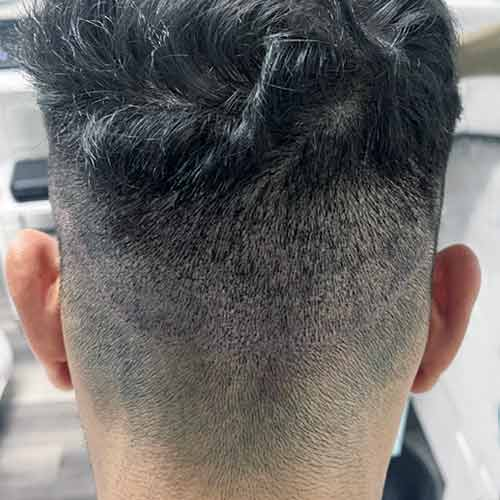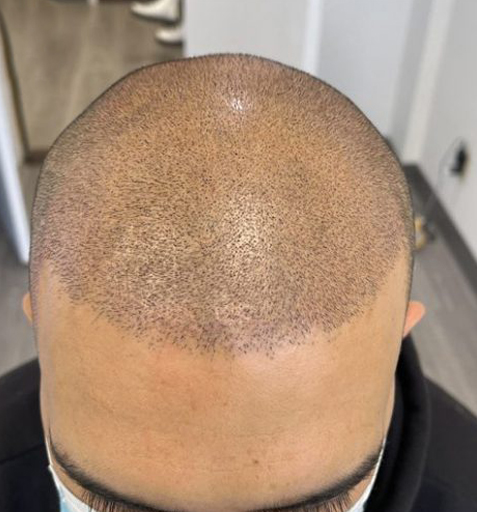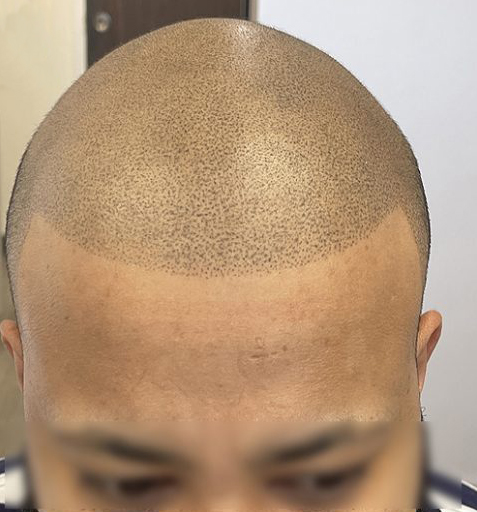Scars tell a story—but not everyone wants to share theirs. If surgical scars, accidents, or hair transplant scars have left you feeling self-conscious, scalp micropigmentation for scar camouflage can help. This innovative solution blends expert artistry with advanced techniques to restore your confidence and transform your appearance.
At Hair Tattoo, we specialize in SMP scar camouflage, a non-invasive treatment designed to conceal scars and blend them seamlessly with your natural hair. We can help you hide an unwanted scar or improve the overall appearance of your scalp.
Scalp Micropigmentation (SMP) can blend any scar into your natural hairline or scalp, regardless of how it developed. Our advanced scar camouflage techniques tackle various scar types. We will ensure you no longer feel self-conscious about your appearance.
Conceal the visible signs of FUT or FUE procedures that disrupt your scalp’s natural appearance. SMP seamlessly blends both linear scars from strip surgery and dot-like scars from follicular extractions. Restore the look of a full, even hairline and eliminate any traces of past treatments with precision pigment application.
Cover scars caused by accidents or head injuries that create unevenness on your scalp. We ensure that your scar blends in naturally by using pigments that are specifically tailored to the color and density of your hair. No matter the size or age of the scar, we provide a flawless look that boosts your confidence.
Mask surgical marks that may interrupt your scalp’s smooth texture or hair growth patterns. SMP restores a balanced, natural scalp appearance, even with small incision lines or larger scars. Our expert technique ensures the pigment matches your skin tone perfectly for an undetectable finish.
Camouflage even tough-to-conceal burn scars with SMP’s advanced technology. Our precise application replicates hair follicles or creates uniform shading to minimize visibility. Our procedure guarantees that your scalp appears uniform, improving both appearance and self-esteem, regardless of how severe the scar is.

SMP scar camouflage has numerous advantages. It can hide any scar and make it less noticeable.
Feel unstoppable with scars that blend naturally into your hairline. Stop hiding and start embracing your new, flawless look every single day.
Achieve a seamless, polished look with no visible gaps or inconsistencies. Our scar camouflage transforms your scalp to let you focus on what truly matters.
Skip the hassle of daily concealers or powders. This long-lasting solution keeps you ready to face the world—effortlessly and confidently.
Our SMP technique is compatible with all hair types, from straight to curly, thick to thin. Custom solutions ensure your scars stay invisible.
Enjoy a minimally invasive procedure tailored for your comfort and safety. Get stunning results without surgery or lengthy recovery times.
See noticeable improvements right after your first session. Step out with confidence knowing your scalp looks natural, even up close.
Our scar camouflage tattooing process is tailored to your unique needs. You will get the most natural and transformative results. Here’s what you can expect at every step:
Your journey starts with a one-on-one consultation where we focus on your needs and expectations. During this session, we examine your scars to understand their size, texture, and color. Together, we’ll discuss your goals and preferences, including how you want the final result to look.
Expert pigment matching is necessary to achieve a seamless appearance. We use advanced technology to analyze your scalp’s natural tone and your existing hair color. This ensures that the pigments we select blend flawlessly with your skin and hair, creating a completely natural appearance.
This is where the transformation begins. Our skilled technicians use state-of-the-art tools to deposit pigments into the scar tissue with meticulous precision. They create density and make sure the scar blends into your hairline by layering on scars that resemble natural hair follicles.
Your results matter, and so does your satisfaction. After completing the initial session, we provide detailed aftercare instructions to help you heal effectively and maintain optimal results. A follow-up appointment is scheduled to refine the work, make minor adjustments, and ensure perfect pigmentation.

Let us help you turn the page on scars and open a new chapter of confidence. You’ll love the way you look and feel—with our expertise in scar camouflage tattooing.
Book your consultation now and take the first step toward flawless, natural results.
Scalp micropigmentation offers a lasting solution to transform scars and restore your confidence. Evaluate these points to decide if it’s the right fit for your needs!
Our clients consistently experience life-changing results. Scars that were previously the subject of unwanted attention now seamlessly integrate into their hairlines with the help of scar camouflage tattoos.
Choosing Hair Tatto for your scalp micropigmentation needs means trusting experts who prioritize your confidence. Our skilled technicians specialize in scar camouflage tattooing. They deliver results that are natural, precise, and tailored to your unique needs. We use advanced tools and premium pigments to ensure long-lasting outcomes that blend seamlessly with your hairline. Choose us for transformative results and unmatched care—because you deserve nothing less.
You don’t have to let scars define your look. You can get a polished, natural look with scalp micropigmentation for scar camouflage that lets your confidence shine.
Our skilled team is ready to help you control your appearance and feel amazing every day. Contact us today to schedule your free consultation and discover the transformative power of SMP scar camouflage.






© 2024 HAIRTATTOO.CA | Scalp Micropigmentation & Trichology Centre
